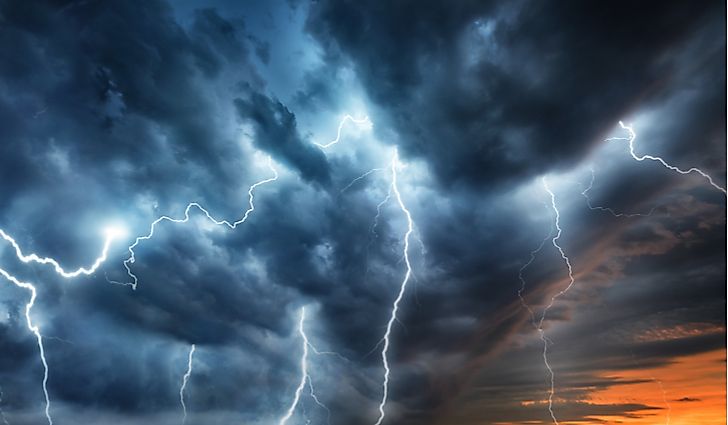What is Weather?

Description
Weather refers to the state or conditions of the atmosphere, and describes variables including whether it is hot or cold, stormy or calm, and wet or dry. Some common weather occurrences include rain, snow, rain, dust storms, and fog. Most of these phenomena occur in the troposphere, which is the part of the atmosphere closest to Earth’s surface. Weather describes the state of the atmosphere in the short-term, such as day-to-day, whereas climate describes the state of the atmosphere over the long-term.
A number of factors, such as air pressure, moisture differences, and temperature, affect the weather of a particular place. The Sun’s position, which changes throughout the day, is an important determinant of these three factors. For example, the further the Sun is from a location, the colder that location will be. For this reason, areas around the poles, which are farthest from the Sun, are some of the coldest places on Earth. Differences in temperature on the Earth’s surface lead to differences in atmospheric pressure.
Weather Forecasting
Weather forecasting refers to the application of scientific principles and technology to predict the atmospheric state for a particular place and time. Weather forecasting has existing informally for thousands of years, and more formally since at least the 19th century. Forecasting is done by collecting current and past weather data and then applying scientific principles and understandings of the atmosphere in order to predict future weather conditions. Computers and weather models are now heavily involved in weather forecasting, but human input is still needed.
Weather forecasts are often relatively accurate and reliable for predicting atmospheric conditions in the near future. However, over a longer period of time, accuracy is reduced due to a number of factors. However, meteorologists can pick the most suitable prediction model to help reduce errors.
In the short-term, the accuracy of predictions has become important to various day-to-day activities all over the world. For example, the agricultural sector relies heavily on forecasts to determine planting seasons. Utility firms also use forecasts to estimate the future demand for a particular product. On a more mundane level, people rely on forecasts to determine the appropriate attire to wear on a given day. In addition, weather forecasts are used to plan outdoor activities.
Effects of Weather on Humans
Weather has affected the distributiuon of human populations. In some parts of the world, extreme weather events have caused some areas to have shifting populations. For example, Hurricane Katrina in the United States forced approximately one million people to move. In fact, the hurricane resulted in the largest single displacement in the United States over a short period of time. In history, weather events that have caused population changes, include the Kamikaze winds in Japan (1281) and the 1565 hurricane in Florida. The Kamikaze winds stopped the invading forces from Mongolia, while the Florida hurricane stopped a French attack.











